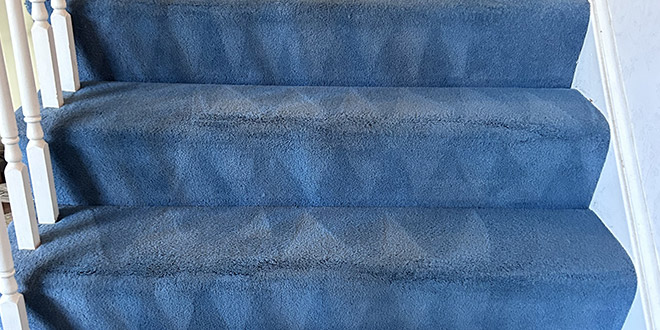The debate over carpets' impact on allergies and asthma has evolved significantly over the years. During the '80s and '90s, studies consistently showed the negative effects of carpeted floors on perceived indoor air quality. They linked them to adverse health outcomes, particularly among those with asthma and allergies. However, recent research has challenged some of these traditional views, leading to a more nuanced understanding of how carpet interacts with indoor air quality.
A significant study by Tulip Carpet Cleaning of Woodbridge demonstrated that effectively cleaned carpets can trap allergens and other particles, resulting in fewer particles escaping into the air. Our research found that even before cleaning, allergen levels (including cat and dust mite allergens) were lower in the air over carpets than over hardwood flooring, even after disturbance from activities like walking or bouncing a ball.

Recent scientific studies have revealed that the relationship between carpeting and indoor air quality is more complex than previously thought. Research shows that while carpets can accumulate more dust and allergens compared to hard floors, they may actually help improve air quality by trapping particles that would otherwise remain airborne.
Dust mites represent one of the most common indoor allergen sources. These microscopic organisms require specific conditions to thrive:
During sleep, humans lose approximately 33 ounces (one liter) of sweat, which creates ideal conditions for dust mites in bedding and mattresses. From there, these mites can spread throughout the home. However, contrary to popular belief, carpets aren't their preferred habitat unless conditions are particularly humid.
Below is a detailed comparison of different carpet types, including their suitability for allergy sufferers and specific characteristics:
Modern carpet manufacturers have developed several innovations to address allergy concerns. For example, Westex Carpets offers an Allergy Guard treatment that protects against allergens, pests, and bacteria. This permanent treatment prevents the decay of human skin and hair into the material that dust mites consume.
Research consistently shows that maintenance is crucial in determining whether carpeting helps or hinders indoor air quality. A well-maintained carpet can act as an effective air filter, while a poorly maintained one can become a source of allergens. Professional cleaning studies have demonstrated that thorough cleaning can significantly reduce allergen levels in carpets.
The effectiveness of different cleaning methods varies significantly. Hot water extraction combined with HEPA vacuum filtration provides the best results for allergen removal. Regular professional cleaning is essential, as domestic cleaning alone may not sufficiently remove deeply embedded allergens.

Recent studies have identified several critical environmental factors that influence how carpets affect indoor air quality:
Different environments require specific approaches to carpet selection and maintenance. Studies have found significantly higher concentrations of allergens in carpeted areas in schools and daycare facilities than in non-carpeted spaces. However, proper maintenance protocols can effectively manage these levels.
The trend toward energy-efficient, tightly-sealed buildings has implications for carpet-related allergies. While these buildings are more energy-efficient, they can trap indoor pollutants, making proper ventilation and carpet maintenance even more crucial.
Current research suggests that the focus should be on:
For those with allergies considering carpet installation, research supports several key recommendations:
"I have had bad allergies all my life. Literally, no airflow through my nose when it is really bad. The first thing we did before moving in was tear out the carpet. I cannot recommend it enough. My asthma has improved, I am wheezing less, sneezing less, and overall feeling so much better."
"I had carpeting and cats for years, and even after vacuuming, people with allergies could only be in the house for 30 minutes. I put in hardwood floors a few years back, and now people with allergies have spent the night here with the cats. Getting rid of carpet makes a huge difference."
Other homeowners shared similar experiences, emphasizing the importance of cleaning, proper maintenance, and sometimes, removing carpets altogether.
The latest research indicates that the relationship between carpeting and allergies is not as straightforward as once believed. While carpets can accumulate allergens, proper selection, installation, and maintenance can make them a viable option for many allergy sufferers. The key lies in understanding specific needs, choosing appropriate materials, and maintaining consistent cleaning protocols.
Modern carpet technologies and maintenance practices have significantly improved the ability to manage allergen levels in carpeted environments. However, individual responses vary, and what works for one person may not work for another. The decision to install carpet should be based on specific circumstances, including:
Success with carpets in an allergy-sensitive environment requires an ongoing commitment to proper maintenance and awareness of individual sensitivities. Our professional cleaning services can be a crucial part of the solution for maintaining carpets in homes with allergy sufferers. Regular and thorough carpet cleaning is essential to minimize allergens trapped in carpets, which can significantly alleviate symptoms for those sensitive to indoor allergens.
Our team is equipped with advanced cleaning technologies and products that are specifically designed to reduce allergens without compromising the quality or appearance of your carpets. With appropriate care and attention, carpets can provide comfort and aesthetic benefits while potentially contributing to better indoor air quality for many individuals, including those with allergies and asthma.